 Patras is the third largest city in Greece and the largest city in the Peloponnese. The place has a long history, as there are several sites in the hills overlooking the modern city at which traces of prehistoric settlements have been found, including the Mycenaean settlement and cemetery at Voudeni.
Patras is the third largest city in Greece and the largest city in the Peloponnese. The place has a long history, as there are several sites in the hills overlooking the modern city at which traces of prehistoric settlements have been found, including the Mycenaean settlement and cemetery at Voudeni.
One prehistoric site, Aroe, eventually became an important city in the Classical period, at which time it was connected to its port by a corridor protected by long walls, similar to the way in which Athens was connected to Piraeus. The city’s name was changed to Patrai (usually rendered in English using the Latin spelling of Patrae) by the Achaeans when they took over, and it became part of the Achaean League in the Hellenistic period. However, when the League — along with the rest of Greece — fell to the Romans in the middle of the 2nd century BCE, it became a Roman city, developing into one of the key port cities of the Peloponnese.
There are several traces of Roman Patrae among the sprawl of the modern city. The most monumental site is the heavily restored Roman odeon.
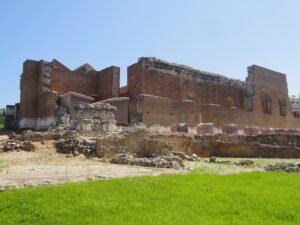
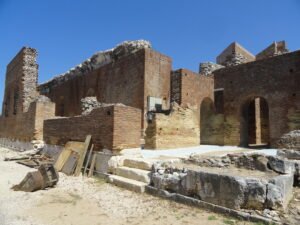
About 100 meters northwest of the odeon was a structure which some have called an amphitheater while others have called a stadium. Whatever you prefer to call it, the area where its ruins have been found covers several city blocks, and most of them have modern structures now, but there are several spots where you can see traces of the ancient structure which once stood there.
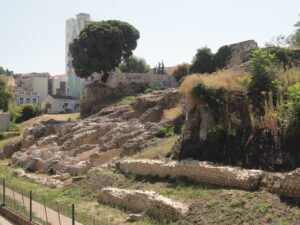

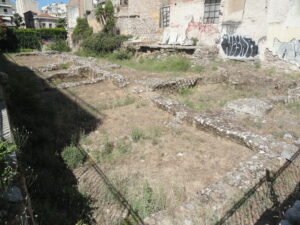
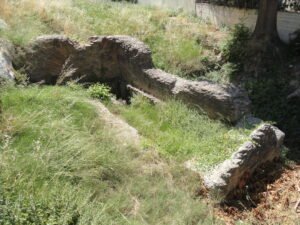
There is also a roofed rockpile on Londou Street about 270 meters east of the odeon which is signposted as a “Cryptoporticus of the Roman Period.” These were covered passageways that resembled tunnels and were usually partially underground.
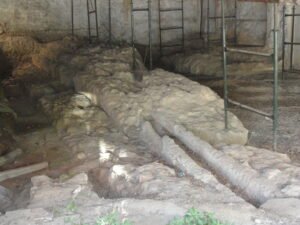
Some Roman structures can be found at the edges of town. On the eastern side, you can find the ruins of a Roman aqueduct on the side of the highway heading up through the hills. Also, in the northern part of town there is a Roman bridge dating to the 2nd or 3rd century CE a half kilometer up the highway from the Archaeological Museum of Patras.
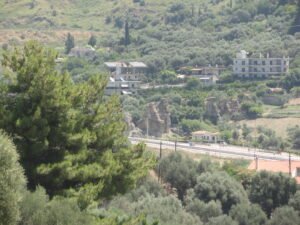
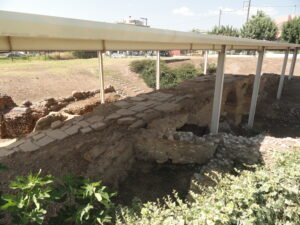
One of the most famous events in antiquity which is said to have taken place in Patras was the martyrdom of Saint Andrew the Apostle. Christian tradition has it that he was crucified by the Romans in Patrae while preaching the Gospel there, and a church was later built on the traditional spot of his crucifixion. In the 1970s a more modern church was built right beside it (which some claim to be largest in Greece). The site of Saint Andrew’s crucifixion was traditionally defined as having been next to a spring which served as an oracle to the goddess Demeter. The spring is still there — just three blocks south of where the Roman harbor used to be — and is housed in a structure which has rebranded it as being connected to the saint.



The Archaeological Museum of Patras is a great place to learn more about the antiquity of the region as well as view artifacts discovered there, including in Patras itself.

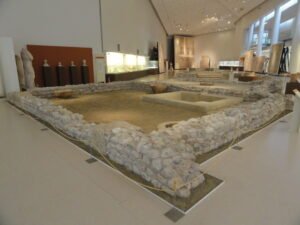
Tips for the Visitor
Patras is easily reached from Athens by bus in less than three hours. The city also has an airport and a ferry port with boats to some of the islands to the west as well as destinations in Italy.
The Roman sites pictured in this article are fenced in but easily visible from their adjacent roads (although you cannot get very close to the ruins of the aqueduct on foot as it it is on the side of a highway). The odeon is normally open for visitors to enter during its opening hours, but at the time of our visit it seems to have recently closed temporarily due to restoration works. The gate of the small building housing the fountain next to the older of the two churches dedicated to Saint Andrew is sometimes open to allow visitors access.
The new and very modern Archaeological Museum of Patras opened in 2009, replacing a smaller museum which was in the city center. The new location is a bit far from the center, but it is definitely worth a visit. The medieval castle near the main Roman ruins is also a must-see for visitors, especially for those looking for nice views of the city. And if you are looking for a glimpse of the area’s Mycenaean heritage, Voudeni is only a short drive up into the hills.
Location Map
